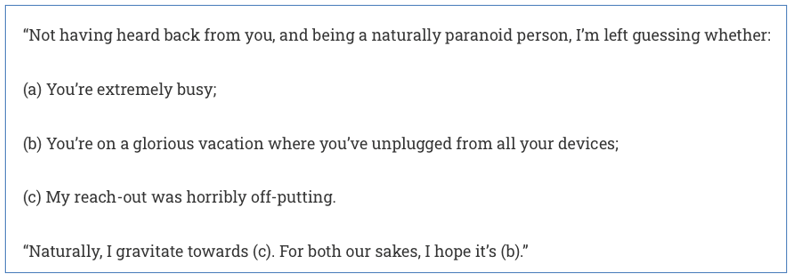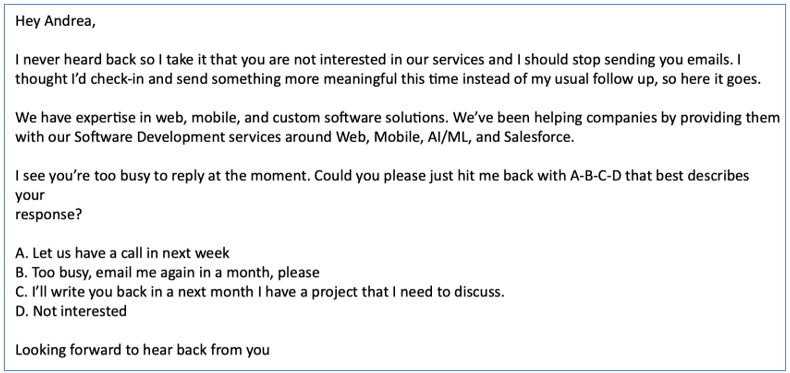This post is part of our Monthly-ish Tips series.
Sometimes you take a communication risk with clients and get rewarded with unexplained silence. For example, you might call for no other reason than to say hello, leave a message when they don’t answer, and then never hear back. So, what if anything should you do about that? In 2018 I wrote about an unconventional way to break the silence, then not long ago I was on the receiving end of a very similar strategy … and hated it. This post is dedicated to what I learned from this experience.
In short, the strategy for which I advocated when you’re feeling a “vulnerability hangover”—a term that some attribute to research professor Brene Brown—is a paradoxical one: take a bigger risk. I excerpted a clever multiple-choice example that my co-author Charlie Green used via email when, instead of the feedback he expected following a high stakes client engagement, he got silence. We’ll call this Case 1:

Now, compare this to the multiple-choice example that I received recently from someone I don’t know. We’ll call this Case 2:

The strength of my negative reaction to Case 2 had me momentarily reconsidering my prior recommendation. But only for a nanosecond, because it didn’t take long for me to realize at least five key differences:
- When there is no basis of relationship, the multiple-choice lands as gimmicky rather than genuine, manipulation not caring.
- Ditto when there’s no personal risk-taking.
- Without humor (which is a type of risk), there’s nothing to help all parties have at least a little chuckle if not a good laugh. Levity can interrupt a pattern and set a different tone.
- When the communication continues to push/convince, then it’s not about caring for the relationship but striving for the sale.
- A message that tries to do too many things at once fails to focus on the fundamental issue: the silence and how best to move forward in the face of it.
You may see other differences—I’d love to hear more.
In the end, Charlie’s message got an immediate response from the client, who as it turns out was extremely busy. My person’s message got a “block sender” action. Ironically, had they done something risky or that invited some no-kidding authentic human connection or both there is at least a chance they would have gotten a more positive response.
Most of you out there aren’t telemarketers hoping for a 1% hit rate from your email blasts to strangers. But it’s precisely because there is a basis of relationship with your clients that their silence can be especially nerve-wracking—that is, unless you’re unusually cool as a cucumber when you don’t know what meaning to ascribe (in which case I admire you and aspire to be more like you).
The next time you think you’re being ghosted by a client, consider that your next best trust-building move is in fact the one that defies logic: take a new risk.
Make It Real
This week, experiment with unconventional ways to break the silence with your clients. Bonus points if anything you do is humorous or clever while also requiring a good dose of your own vulnerability.
Learn More
Read about how regular experiments to help you stretch outside your comfort zone can be a valuable tool for managing your own self-orientation in Chapter 10 of The Trusted Advisor Fieldbook.
You’ve got this.
Andrea Howe
Latest posts by Andrea Howe (see all)
- Role models for healthy candor - May 27, 2025
- A small gesture (and related risk) with big trust impact (Part II) - April 1, 2025
- A small gesture (and related risk) with big trust impact (Part I) - March 3, 2025
